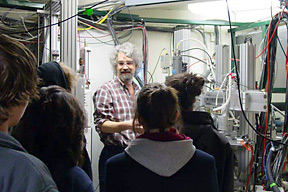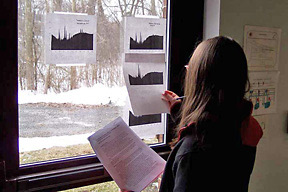High school students visit campus to learn how chemistry informs the humanities and social sciences
By Ernest Fontes



To learn about chemistry in action -- and that chemistry is more than just a textbook exercise but also a tool for humanists and social scientists -- nearly 100 Ithaca High School sophomores and juniors trekked across the Cornell campus for two days in March, visiting the Johnson Art Museum, the Cornell Ceramics Studio and the Cornell High Energy Synchrotron Source (CHESS).
"I know all of you want to become scientists when you grow up" was one of the first greetings many of the students encountered. This icebreaker evoked some chuckles but also grumbles, which hint at how hard it is for high school teachers, such as Kate Gefell, the chemistry teacher who organized the trip, to convey an appreciation for science in many teenagers. The trip to Cornell was an opportunity to build that appreciation through direct experiences.
At the Johnson Museum, students learned how infrared reflectography helps art historians authenticate and examine buried features in art without altering or endangering a piece. A hands-on activity at the ceramics studio introduced the chemistry of glazes. Students were able to design their own sample tiles to observe how glazes change composition and color during the firing process.
At CHESS, students first heard from Joel Brock, professor of applied and engineering physics, about particle accelerators and X-ray production, then about the wide variety of science done with X-rays. A hands-on activity with X-ray fluorescence (XRF) -- the light, or glow, given off by a specimen when it is hit by high-energy X-ray beams -- gave the students an opportunity to record spectra from such stone artifacts as flint, chert or arrowhead specimens.
On a tour of CHESS, students viewed protein crystals using a binocular optical microscope with Richard Gillilan, a staff scientist with the MacCHESS group (who support macromolecular crystallography at CHESS). Gillilan described how scientists carefully mount the soft crystals, freeze them with liquid nitrogen and then collect X-ray diffraction photographs.
At a second stop on the tour, sitting in front of a large computer display, MacCHESS scientist Marian Szebenyi described how spotted X-ray diffraction photographs can be digested by computers to create three-dimensional models of complicated protein molecules. Students eagerly donned special oversized eyeglasses that let them see a true three-dimensional model of a molecule rotating on the computer screen.
John Chiment, a paleontologist by training and an outreach consultant, described how tracing geographic origins revealed subtle information about trade routes and travel of settlers in the early history of the United States. Combined with what they learned at the Johnson Museum about chemical analysis and art, this XRF lab reinforced the notion that the tools of chemists, physicists and even large-particle accelerators can play a role in the humanities and social sciences.
In their written feedback, some of the students' comments hinted at the subtleties of science: "I figure if they can cure one virus it is just a springboard into curing many others." Others showed a hint of inspiration, such as this female student: "Working as a physicist now seems like a potential future to me."
The trip was funded by a local nonprofit organization, the Ithaca Public Education Initiative, which also provided Gefell with funds to bring a number of demonstrations into her classroom over the course of the year, including one by a local blacksmith who showed students how to work copper stock into a teacup.
Ernest Fontes is assistant director of the Cornell High Energy Synchrotron Source.
Media Contact
Get Cornell news delivered right to your inbox.
Subscribe